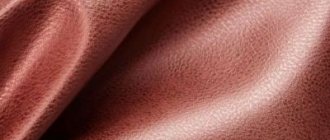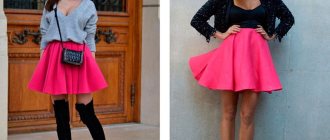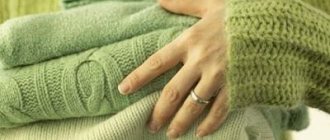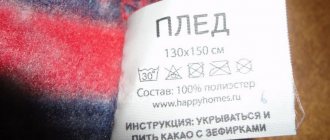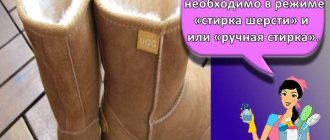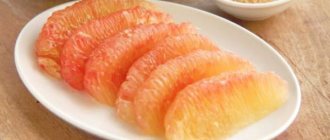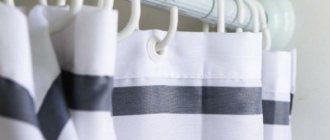Microfiber is a new unique material from which towels, cleaning cloths, bed linen and sportswear are made. All products made from this fabric are soft, do not wrinkle, are breathable and easily absorb moisture. With proper care, they can last for several years without losing their properties. The main thing is to know how to wash microfiber correctly. Following simple recommendations will help maintain absorbency, softness and color.
What kind of fabric is this and what is it afraid of?
Microfiber is woven from the finest fiber - polyester, polyamide or nylon. It is used to make bedding, towels, cleaning equipment, furniture, eyeglass wipes and car seats.
Synthetics do not tolerate hot water, ironing, bleaching and aggressive detergents. It is also not recommended to twist it too much when spinning, although the material is resistant to deformation. The fabric does not like the effects of fabric conditioner; because of it, it loses its unique properties.
For information: Due to improper care, microfiber does not tear or lose its properties instantly, but it wears out noticeably faster. If you wash the products correctly, they will last for several years.
Manufacturers usually indicate on the label how to care for the material, whether it can be machine washed or whether it is recommended to remove dirt manually. There is also information about temperature conditions.
Basic Rules
Improper washing can damage the product by disrupting the fiber structure. There are several rules that will help you understand how to wash microfiber correctly:
- the water temperature should not exceed 40-600;
- do not boil;
- do not dry in a car or on a radiator;
- You cannot iron such products;
- Do not use bleach, especially with chlorine, to remove stains.
It is also important to know how to wash such products. It is recommended to use laundry soap or liquid laundry detergent. The powder is difficult to rinse out of microfiber fibers and will make the fabric hard.
Advice! It is not recommended to add conditioner. It also clogs the fibers, after which you will have to rinse the item thoroughly.
Handwash
Getting rid of stains without a washing machine will not be difficult: all dirt from microfiber can be easily removed with soap and powder.
Basic washing rules:
- put the products in warm water, the temperature of which should not be higher than 50 degrees;
- boiling is unacceptable: microfibers become deformed and the towel becomes unusable;
- use laundry soap, non-aggressive washing powder, liquid detergent;
- pre-soak heavily soiled kitchen and floor rags for 1 hour;
- there is no need to rub the material vigorously, stains can be easily removed using detergents;
- rinse things only in clean water, without conditioner;
- dry synthetics in the room or outside away from colored laundry: although microfiber itself does not fade, it quickly absorbs paint.
Advice It is better to use a powder with a pH of less than 10 units.
Everything you need to know about microfibers. Tips and tricks
In this useful article we will tell you:
— What is the difference between different types of microfiber.
— What is the principle of “work” of this type of towels.
— How to choose the right fabric to solve your problems.
You will also learn how to properly care for them and save a lot of money, and understanding what detailing products can be used with a particular fiber will make your work as fast and efficient as possible.
Interesting? Then let's begin
CHOOSE THE RIGHT FABRIC FOR THE JOB AND ACHIEVE THE BEST RESULTS! We all know that microfiber cloths are not only a detailer's best friend, but also an essential tool for almost every cleaning and finishing process. However, the question is how well you understand them, because not all fabrics are created equal!
There are different types of microfiber towels, all with their own characteristics that make them ideal for many different tasks. So to achieve the best results - whether it's cleaning, polishing or adding a final polish - it's always best to have a cloth on hand that's designed specifically for the job at hand. And what's more, it's important to purchase the highest quality fabric so that you don't damage your paintwork and so that it lasts as long as possible, while keeping your costs down.
WHAT IS MICROFIBER? Although we often use the word as a general term for the entire towel when describing these accessories, it actually refers to each individual fiber, which should be finer than 1 denier, which is roughly equivalent to one strand of silk. Most of the fabrics we use in the automotive industry contain microfibers ranging from 0.1 to 0.3 denier, which is 200 times thinner than a human hair. They are also made from a synthetic blend of polyester, which makes up most of the structure, and polyamide (nylon), used to increase moisture absorption and density. These proportions are usually 70:30 or 80:20 respectively.
During the manufacturing process, these individual fibers are split and woven into various designs, the most common being closed loop, waffle and twisted loop. All of them, along with short and long pile designs, have different attributes that make them ideal for specific applications.
HOW DOES IT CLEAN AND DRY THE SURFACE?
In addition to being used in combination with a wide range of cleaning and finishing products, microfiber fabrics have their own cleaning and drying abilities due to the split fibers, weight and weave design.
For example, when you run a short, shaggy, closed-circuit microfiber cloth (such as Auto Finesse Work Cloth) across your palm, it can feel clingy. These are simply fine fibers that penetrate and trap imperfections in your skin. Just think of them as tiny hooks. In much the same way, they will trap and hold dirt and moisture rather than simply pushing it from place to place.
The properties of the fibers themselves are also important. They have a cross section very similar to a sprocket (*) or multi-spoke wheel without a rim. This not only means that it has a significantly increased surface area, but also that it can trap small particles within the strand itself. So, when these fibers pass over any wet or dry surface, they trap small particles (or water molecules) and hold them inside the individual fibers. It is for this reason that dry wiping, say, an LCD screen is always more effective with a microfiber rather than a cotton cloth. Cotton fibers have a round cross-section, so although they trap some dirt between their fibers, this is not enough because the fibers themselves cannot trap small particles. This is why microfiber will actually hold dust and not just move it around.
The second reason fiber is so effective in dry cleaning is even more scientific. During the manufacturing process of splitting, which is designed to make the fibers as fine as possible, more absorbent and give them effective surface area, they are installed with a positive static charge. For this reason, they physically attract and hold negatively charged dust.
WHAT DOES GSM MEAN?
GSM, or grams per square meter, is the dry weight (density) of any given fiber. The GSM value does not depend on the type of weave or pile length, but, as a rule, the higher the GSM, the softer it is and better suited to absorbing moisture (as well as liquid detailing sprays, etc.). If you look at the Aqua Deluxe and Aqua Deluxe XL ultra-deep pile drying towels, which are designed exclusively for drying, they have a whopping 1200 GSM rating and that means they can absorb a huge amount of water. High GSM towels are also suitable for sensitive surfaces such as soft paintwork. For example, Auto Finesse Ultra Plush is extremely absorbent, but this thick 800 GSM plush fabric can also be used effectively for finishing quick polishes, spray waxes and removing residue from other liquid compounds.
Fibers with lower GSM values do not absorb moisture as well and are more suitable for heavy-duty cleaning tasks. For automotive use, I think you won't want to use towels below 250 GSM. For example, the soft and durable Auto Finesse Work Cloth has a density of 300 GSM, and the ASST Allround working fiber has a density of 350 GSM, which makes them universal for all types of detailing tasks.
The last thing to consider about the weight of fabrics is how many washes they can withstand. At least technically, higher GSM promotes greater longevity and will outlast more washes in the washing machine without deteriorating in quality or softness. But, nevertheless, all this is quite insignificant. All good quality fabrics can last for years and last up to 500 washes if cared for properly. If your fibers don’t “live” that long, then think about whether you are taking care of them correctly and do the math. Sometimes it is much cheaper to upgrade to the top tier and buy expensive products, but do it less often than to constantly update your range of cheap towels.
WHAT IS THE IMPORTANCE OF THE TYPE OF TOWEL? The type of weave also affects the quality of execution of each specific task. Closed-loop, short-pile fabrics are generally best for deep cleaning and removing stains using liquid cleaners and removing residue from polishes, waxes, or other coatings. Thick, deep-pile fabrics tend to be softer and more moisture-absorbent, making them great for use with quick detailers, dry cleaning of sensitive surfaces, finishing touches, and water absorption.
The twisted loop weave, in which ultra-deep pile fibers are gathered together, compacted and arranged in a long, twisted configuration, is designed to provide the largest possible area of water absorption from the surface. The Auto Finesse Silk Drying Towel and the ASST TPL 1-Side are great examples of amazingly effective twisted loop towels.
Waffle and tweed fibers also have a huge surface area, making them ideal for absorbing sprays. However, these types of weaves also have the advantage that they have physical “pockets” between the weaves, which allows them to trap and trap larger debris during cleaning. Tweed, for example, is excellent for removing excess hard wax and prevents the risk of damaging the paintwork during finishing polishing.
HOW TO EXTEND THE “LIFE” OF MICROFIBER? As we said before, a towel that is well cared for can last a very long time. Most good quality items can be washed in a washing machine or by hand. The key here is to make sure the synthetic fibers don't melt or clump together, making them sharp, scratchy, and unusable. Therefore, never wash towels at high temperatures, iron or dry them on radiators.
I would also like to note that there are still some points after which it is better to throw out the fibers or use them to do dirty work - this is if they were used to polish the remains of a ceramic coating, were used with bitumen cleaner or adhesive removers, or those that either very dirty, or accidentally dropped on the ground or sand. In such cases, it is much better to throw away the towels to avoid damaging the next part, simply because it is very difficult to wash off solvents/ceramic coatings or wash out every bit of sand and dirt.
Another thing that is almost impossible to completely wash off is fabric softeners. They are designed to leave a layer on fabrics that actually prevents the microfibers from doing their job and trapping moisture and dirt. This is one of the reasons why we never use household laundry detergents, as they may contain this product and cause harm.
Also, never use powder detergents because they can leave powder particles in the fibers that are not completely dissolved. These powder particles are sharp and snowflake-shaped and can therefore scratch sensitive surfaces. We recommend using Micro Wash Gel Laundry Shampoo, which is specially formulated to remove dirt and product residue and condition microfibers so they last longer. It is best to use about 50ml of Micro Wash for hand washing or machine washing at low temperature with a strong spin for maximum drying. Once the towels are air dried, they can be folded and stored for the next part.
Also note that it is best to separate the fabric to prevent cross-contamination. Ideally, you should wash each towel separately depending on the products used on it. But we understand that this is rarely possible and instead we recommend separating short and long pile fabrics for washing separately. Or fibers after abrasive products separately, after non-abrasive products - separately. It also makes sense to wash towels separately to dry the body. This way they will not come into contact with any other contaminants and will not absorb the remains of other products or contaminants.
AUTO FINESSE MICROFIBER RANGE It goes without saying that we offer only the highest quality towels that are designed to help you tackle all your cleaning, polishing and finishing needs. All of them are machine washable, so here are brief instructions on how to use them.
WORK CLOTH
Measuring 400x400mm, these cloths are truly the all-rounders of their range and are capable of performing a range of detailing processes effectively. They have a closed loop, short pile weave, a 300gsm weight and have machine stitched edges for extra durability, making them ideal for repeated use even on very dirty jobs.
We tend to use them as a versatile multi-tool, especially during the cleaning and polishing stages. They are ideal for tough jobs such as cleaning engine bays, interior parts, polishing exhaust pipes and removing polish or ceramic coating residues. This fiber and a bottle of Tripple All-in-One Polish can also be a powerful combo for cleaning and protecting hard-to-reach areas such as the inside of door frames, some metal parts in the engine compartment, trunk openings and behind door handles.
They are also offered in a special Work Cloth Trio package. These are exactly the same towels, but in different colors (turquoise, gray and white), making them easy to identify in your set. This way you definitely won’t get confused about which napkin to take for the interior, which one to remove excess paste, and which one, for example, to remove bitumen stains.
PRIMO PLUSH
Primo Plush is a large towel measuring 600x400mm with very deep fluffy pile. Ideal for final polishing of products. It has extremely high absorbency, making it ideal for use with Finale Quick Detailer and Glisten Spray Wax. Extremely soft, 600gsm with a non-scratch microsuede edge, Primo Plush is suitable for all sensitive surfaces and can also be used for effective dry dusting, removing wax residue and even drying bodywork.
ULTRA PLUSH
Ultra Soft Fiber Ultra Plush 400 x 400mm Ultra Deep Pile 800gsm is not only a stunningly absorbent premium fabric that is ideal for tasks such as removing drips or drying intricate wheels and door frames. But it's also great for removing residue from wax and spray products. Like the Promo Plush, the Ultra Plush features a scratch-resistant microsuede edge.
MICRO TWEED
This wipe has been specially designed for ultra-safe removal of hard wax residue. It measures 400x400mm and is made from soft, short pile microfiber woven into a special tweed pattern to help lift wax residue from the surface and trap it in these pockets, away from the paintwork, when wiped. Features maximum durability and a tightly stitched edge to prevent premature fraying. Best cloth for removing wax.
SUPERIOR WAFFLE Superior Waffle 600x400mm is primarily designed for use with glass cleaning sprays such as Crystal Glass Cleaner and Caramics Glass Cleaner. Soft and absorbent, the Superior Waffle quickly mops up liquids while lifting dirt and depositing it off the surface into special recessed pockets. The ideal towel for quickly cleaning glass without streaks.
GLASS WAFFLE This microfiber can also be used with glass cleaners when more intensive cleaning is required. It has a slightly stiffer microfiber than Superior Waffle, so it absorbs moisture a little less, but provides an additional “scrub effect” to remove stains and restore tired glass. Where this really comes in handy is when working with Vision Glass Polish. The perfect towel to interact with this product. Again, it has a significantly increased surface area compared to many traditional waffle towels and will keep polish residue and debris deep in the pockets, away from the surface.
DUO EDGELESS Duo Edgeless 400GSM towel is the perfect dual-use microfiber. One side has a dense, short-pile surface that's ideal for removing wax residue and buffing, while the other side has a deep, plush pile that's great for spreading paint detailing spray or soaking up excess from any other liquid compound. both interior and exterior. Its 600x400mm dimensions and edgeless design ensure ultra-safe wiping and ease of use.
AQUA DELUXE & AQUA DELUXE XL Aqua Deluxe is a very soft plush towel with a density of 1200 g/m2, capable of absorbing huge amounts of water. Designed exclusively for safe and easy body drying, it features a super-absorbent inner core, a non-scratch edge for increased product durability and a huge 500x700mm size. There is also Aqua Deluxe XL, which has the same characteristics, but is even larger - 570x940 mm.
SILK DRYING TOWEL
This towel with a twisted loop design is ideal for drying your car very quickly without abrading wax or coatings. This design actually offers the most effective water absorption and works effectively on paintwork, glass and even wheels. The extra large Silk Drying Towel measures 920x620mm and fits any size car for the fastest drying experience.
I hope that this article will help you in choosing the right towel for certain tasks and that your subsequent car care work will be even more enjoyable and effective. Well, if you still have questions, write to us in any convenient way and we will be happy to advise and help.
In the washing machine
If you don’t have the time or desire to soak and wash microfiber by hand, you can use an automatic machine.
We recommend: At least not to spoil it: how and on what mode should you wash your shoes in a machine?
The recommendations here are:
- Since the fabric is voluminous, the drum is ¾ loaded.
- Washing is done in a delicate cycle: too intense rotation damages the fibers.
- There is no need to put in too much powder, just fill the compartment as for a normal cycle.
- Wash microfiber cloths separately from other items, as lint and hair may collect on their surfaces.
- Temperature: 40-50 degrees.
- Do not wring out microfiber in the washing machine; it is better to remove moisture manually.
Important When choosing a microfiber washing powder, make sure that it does not contain bleaching particles or conditioner.
Rules for washing bulky microfiber items
An increasing number of residents are seeking to diversify their wardrobe with high-quality and comfortable models made of ultra-durable and soft-touch material. But how to wash a microfiber jacket to preserve its original appearance without deforming the structure of the fabric. It is recommended to use a spacious container where the item of clothing can be conveniently placed if you decide to wash a jacket or blanket by hand. When loading a bulky item into the drum, it is better to wash it without loading the washing machine with other items.
Those who have no experience caring for newfangled fabric are puzzled by how to wash a microfiber blanket in order to maintain the softness of the fibers. It is a serious mistake to use conditioner, which is contraindicated for this texture. If conditioner was added by mistake, you will have to thoroughly rinse the items after washing in several waters.
If the product is heavily soiled
In this case, long soaking is used for 10-12 hours. You need to dissolve the detergent in water and immerse things in it, then rinse thoroughly. If you fail to wash the towel the first time, re-soap and rinse it.
To tidy up a dishcloth, you can pre-treat it with a paste of baking soda and water and immerse it in a soapy solution for an hour, then rinse thoroughly in water.
Another method that is familiar to housewives is using lemon juice as a stain remover. The recipe is as follows: juice from half a fruit is squeezed into a basin with 5-7 liters of warm water and the cloth is immersed for a couple of hours. If dirt is deeply absorbed into the fibers, you can squeeze out a whole lemon, then wash it as usual.
To remove stains, you can use Vanish, which is gentle on fabrics. The drug should be diluted according to the instructions; usually the contaminated napkin is kept in the solution for half an hour.
Is the fabric capricious?
The second name of this material is microfiber. Where is it from? The fact is that microfiber consists of the finest polyester threads that are intertwined with each other.
It is believed that this material is unpretentious; caring for it does not require special knowledge and skills. But:
- microfiber, like other synthetic fabrics, does not tolerate high temperatures;
- The use of aggressive cleaning agents, bleaches and rinse conditioners is not recommended. Do not vigorously wring out microfiber products.
Important! Manufacturers claim that even after two or three washes performed without taking these nuances into account, the item will not deteriorate. This process occurs gradually. It’s just that the fabric will last noticeably less than the period stated by the manufacturer.
What to buy for your home?
Microfiber is used everywhere in modern cleaning products. For effective cleaning you will need:
- Napkins. They are inexpensive and sold in any supermarket. They can successfully wipe furniture, glass, mirrors, household appliances, and glasses. It can be used both wet and dry. By the way, wipes for cleaning glasses or monitor screens, which resemble soft suede, are also microfiber.
- Mop for mop. This is a flat rag, which, thanks to the “ears”, fits onto the same flat mop - flounder. It has excellent absorbency - it can not only wash the floor, but also collect water or other spilled products from it. You can have several mops of different colors and wash certain rooms with them, or simply alternate one with the other so that you can use a clean rag every day.
- Floor cloth. If you use a classic mop or a lazy one, don’t waste money on a microfiber cloth. You will like the result.
- “Fur coat” for a mop for washing windows. It is convenient if the nozzles are changed: first, the window is washed with microfiber, and then cleaned and polished with a rubber squeegee (we talked in detail about washing windows in the article “How to properly wash windows” ).
- Wiping cloths for crystal and dishes. As a rule, they are used dry.
Advantages and disadvantages
Advantages of the material:
- excellent absorbent properties;
- breathability;
- can be painted in all colors;
- the color does not fade; ease of care;
- has antifungal quality;
- durable without deformation.
There are some disadvantages:
- Allergy to microfibers may occur;
- Thanks to static electricity, it attracts dust and lint;
- high price.
How to dry it properly?
Washed items are hung on hangers indoors. The hood should be unfastened and hung separately. There is a slight draft in the room to prevent moisture from accumulating in the air. The jacket is placed away from the window, preventing direct sunlight from hitting it.
It is prohibited to speed up the drying process using:
- central heating batteries;
- hairdryer;
- iron;
- direct sunlight.
Under no circumstances should you dry membrane clothing on a regular clothesline. The product runs the risk of stretching from its own weight and losing its attractive appearance.
The dried sets are stored in the closet, hanging on hangers. To protect the membrane from dust, items are covered with a plastic bag.
Is whitening possible?
We remind you that when cleaning microfiber products, it is not recommended to use detergent compositions containing aggressive bleaching components. The use of “Whiteness” or other similar products will cause new stains to appear on the fabric, which will be impossible to remove. It is better to give preference to delicate whitening.
It is forbidden to wash microfiber with bleach and other serious bleaches.
Vanish bleach has a mild effect. But it is important to measure the portion correctly, following the instructions on the package. If the norm is not followed, the concentration will increase and damage the sensitive fibers. Also, do not forget that the water should be heated to 40 degrees, and soaking should not take more than 30 minutes. After bleaching, rinse the item thoroughly and start a full wash.
Microfiber
Microfiber was first produced in Japan in the late 70s. It got its name from fibers several micrometers long. The thread began to be twisted from the molten plastic mass, which made it possible to make the fibers very small.
For the production of microfiber, polyester and polyamide fiber are usually used. However, today microfiber can be obtained from cotton, viscose and other types of raw materials.
Microfiber is widely used in clothing, woven and non-woven fabrics, knitwear, tights and socks. It is also used to make furniture upholstery, filters and cleaning supplies.
Impregnation at home
Manufacturers impregnate membrane fabric with a special composition that protects it from getting wet. Over time, the composition is washed out, and the jacket begins to let moisture through.
The protective layer is restored using special products, which are produced in 2 types:
- Aerosols are sprayed onto the outside of the fabric. The spray makes the material waterproof again. Processing is carried out outdoors.
- Liquid impregnation revives not only the outer layer, but also the entire membrane layer. The composition is poured into a container, the jacket is completely immersed in it for several minutes.
Freshly washed clothes are treated with an impregnating composition. Treatment is allowed to be carried out no more often than once every two cleanings. Otherwise, the pores in the fabric will become clogged and the “breathing” properties will disappear.
Means for impregnation:
| Brand | a brief description of |
| Grangers Performance Repel Spray | Restores the fabric structure to a new state. Apply to a dry surface from a distance of 20 cm. Maximum effectiveness occurs 24 hours after treatment. |
| Grangers Clothing Repel (wash-in) | Impregnation is carried out in a washing machine. The product does not harm the environment. |
| Nikwax TX.Direct Spray-on | Extends the life of clothing. Sprays from a distance of 15 cm. Suitable for items that cannot be washed in a washing machine. |
| Nikwax TX.Direct Wash-in | The liquid restores the water-repellent layer and does not spoil the breathability of the fabric. Use does not harm health and the environment. |
Caring for the membrane and restoring its properties, video review of the products:
Special membrane cleaning products
Basic rules when choosing a chemical detergent :
- do not use regular crystallized powder,
- you should avoid products that contain chlorine or bleach,
- It is better to use a special product for things with a membrane.
Table of the best products for membrane jackets:
| Brand | a brief description of |
| Nikwax Tech Wash | Suitable for cleaning the membrane (without down filling). Cleans and reanimates the material. In concentrated form it is used to remove individual stains. |
| Granger's 30˚C Cleaner | Restores the water-repellent layer, destroys dirt and unpleasant odors. Suitable for any type of washing machine. Removes stains at a temperature of 30⁰C |
| Perwolle Sport Active Care 3D | Used for processing sports uniforms, does not cause damage to membrane fabric and impregnation. Does not contain phosphates. |
| Granger's Universal Spray Cleaner | The spray is sprayed onto contaminated areas (lapels, collars) from a distance of 10-15 cm. Stains easily come off when wiped with a soft cloth. |
What washing products should I use?
An important rule that must be followed is that there should not be a lot of powder .
It's a good idea to check the label before purchasing a detergent for this fabric . For example, you should discard the powder if it contains bleaching components. It is recommended to look for packaging that states that the pH is less than 10 units . The ideal option would be to wash with powder intended for children's products.
By the way! Microfiber can be easily washed with regular laundry soap. You can grate it and add it to a bowl of water. This procedure is suitable in cases where soaking is required. Another way is to rub particularly dirty areas with a bar of soap, and then rinse the product.


